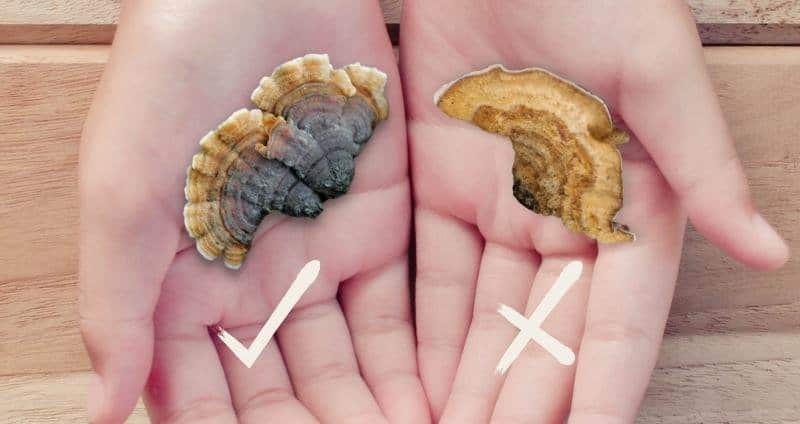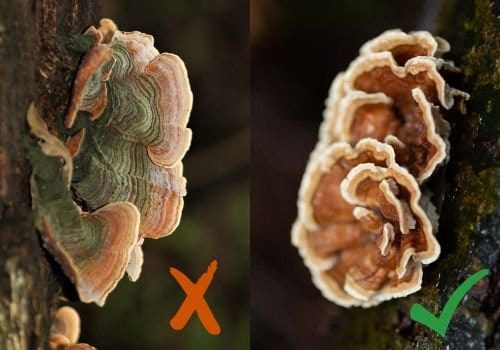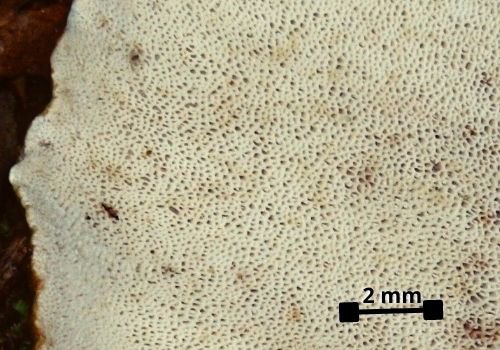Menu


Luckily, when it comes to turkey tail mushroom (fruiting body) identification there are no toxic lookalikes. So, it is a safe mushroom to forage for, even if you don’t end up finding “the real thing.” Because, yes, there are common mushrooms that look similar but will not contain the health-supporting compounds that turkey tail (scientific name Trametes versicolor) is known and valued for.
So, use our 4-point checklist below to help you find the true turkey tail mushroom. You can then put your newfound powers of mushroom deduction skills to good use on your next forest walk. If you decide to forage what you find, you can take some fresh turkey tail home to make a healthy tea.
Turkey tail mushrooms grow abundantly on dead trees and logs in the wild. They are one of the most common forest mushrooms. Turkey’s tail can come in a wide range of colors, and one can look quite different from another.
But it doesn’t end there. Some other wild mushrooms look very much like Trametes versicolor, making things more confusing. These imposters are commonly called “false turkey tail mushrooms” and include Stereum ostrea, Stereum hirstum, and Trichaptum abietinum.

So, how can you tell the difference between “true” and “false” turkey tail mushrooms?
If you come across what looks like Trametes versicolor on your hike, flip the mushroom over. A true turkey tail fungus has visible pores on its white underside, hence why it is classified as a polypore (i.e. many pored) mushroom. Whereas, S. ostrea and S. hirstum have yellow, smooth undersides. You will also commonly find false turkey tail fungi such as S. ostrea mushrooms with algae on them (1).
If you can answer “YES” to all the following questions about the mushroom you’re observing, then you’ve found the true turkey tail!

This video shows the various features of true turkey tails and how to correctly identify turkey tail mushrooms. It gets up close and personal with this mushroom to show you its fine velvety texture, its concentric bands of colors, and how pliable it should be.
The video below not only walks you through how to identify Turkey Tails mushrooms but also how to brew a traditional tea from your foraged findings.
You may want to reap the benefits of these fungi without the labor of identifying turkey tail mushrooms and preparing them. In that case, you can use a powder-form mushroom extract, such as Real Mushrooms’ Organic Turkey Tail Extract.
Simply add 1 to 2 tsp of the powder to a cup of hot water and enjoy this earthy and highly beneficial tea. Like all our products, this extract powder is made from 100% real mushrooms (fruiting bodies) so it contains all the beneficial compounds, unlike products made from mycelium.
Want more information on how taking turkey tail as a supplement or tea can support your health? Read our article Turkey Tail Mushroom Benefits & Science: A Complete Guide.

1. Volk, T. 2000, “Tom Volk’s Fungus of the Month for November 2000,” Tom Volk’s Fungi, <https://botit.botany.wisc.edu/toms_fungi/nov2000.html>.
Disclaimer: The information or products mentioned in this article are provided as information resources only, and are not to be used or relied on to diagnose, treat, cure, or prevent any disease. This information does not create any patient-doctor relationship, and should not be used as a substitute for professional diagnosis and treatment. The information is intended for health care professionals only. The statements made in this article have not been evaluated by the Food and Drug Administration. Any products mentioned are not intended to diagnose, treat, cure, or prevent any disease. The information in this article is intended for educational purposes. The information is not intended to replace medical advice offered by licensed medical physicians. Please consult your doctor or health practitioner for any medical advice.